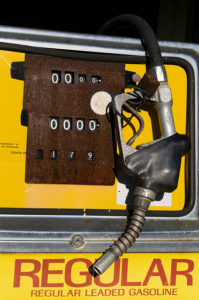Air quality data is regularly measured and analyzed in countries throughout the world, though in some cases there may be lapses in collection for various reasons, particularly for older dates when these measurements were not yet routinely taken. In order to account for missing data, proxies are often used with the assumption that the behavior of the proxies mirrors that of whatever environmental quality measurement is being tested. For example, for air pollution caused by vehicle emissions, one could use the following
![Photo courtesy Joe Mabel [GFDL (http://www.gnu.org/copyleft/fdl.html) or CC-BY-SA-3.0 (http://creativecommons.org/licenses/by-sa/3.0/)], via Wikimedia Commons](http://www.academicwino.com/wp-content/uploads/2016/05/lead-gas-the-academic-wino-300x225.jpg)
Photo courtesy Joe Mabel [GFDL (http://www.gnu.org/copyleft/fdl.html) or CC-BY-SA-3.0 (http://creativecommons.org/licenses/by-sa/3.0/)], via Wikimedia Commons
While it might not stand out immediately as a viable proxy for air quality, wine on occasion has been studied for exactly that purpose. Specifically, some studies in various parts of Europe have shown that lead levels in wine reflect the trend of vehicular consumption of lead, while other studies have found that these levels in wine mirror that of levels emitted from various industrial complexes nearby the vineyards of study.
It is thought that the lead (and possibly other air pollutants) in the air is taken in by the grapes and grapevines during the growing season, which eventually end up in the finished wine at a concentration of a specific ratio to the original levels in the air.
A new study published in the journal Chemosphere, aimed to evaluate whether or not wine could be used as a proxy for lead levels in Australia, since air quality data is limited to one area of Australia (Adelaide), and only publicly available for the dates between 1982 and 2001. Since lead gasoline reached a peak in the 1970s in Australia and began to decrease after 1981 due to federal regulations limiting its use, having a proxy that can accurately correlate to lead levels in the air may be very useful in determining possible human and environmental exposure during that time period.
Brief Methods
Wine samples were collected from wineries in McLaren Vale and Langhorne creek in South Australia including vintages between 1963 and 2012.
For simplicity, all of the wines were either Shiraz or Cabernet Sauvignon, were all from

Photo courtesy Hitchster
grapes within the same region, and were not blended with grapes from any other region.
Soil samples were collected from all vineyards that had given wine samples. Both surface (0-2cm) and sub-surface (below 20cm) soil samples were collected.
Air filters from the central part of the city of Adelaide were collected and analyzed. Air filters were available for the years between April 1997 and June 2003. Additionally, air filters from the north of Adelaide were collected and included filters available for January 2002 through December 2004.
Since the vineyards involved in the study were near zinc-lead-silver mine, samples were collected in 2012 to evaluate other possible sources of lead in the wines.
Lead levels were measured and analyzed in all wines, soil samples, air filters, and mine samples.
Selected Results
- Lead concentrations in the wines ranged from 1 to 328μg/L (average 33μg/L).
- Lead concentrations in the surface soil samples ranged from 5 to 25mg/kg (average 11mg/kg).
- Lead concentrations in the sub-surface soil samples ranged from 4 to 14mg/kg (average 10mg/kg).
- Government air quality data indicated that lead concentrations in the air in the city of Adelaide between 1982 and 2001 ranged between 0.02 and 1.75ug/m3.
- Between 1963 and 2012, lead concentrations in wine samples were found to decrease over time.
- This decline in lead concentrations in wine samples coincided with the decreased use of lead gasoline in vehicles over that time period.
- Air filter samples showed a decrease in lead levels from the mid-1970s onward.
- All lead levels found in the wines were significantly below the maximum allowed in Australian wines (and drinking water for that matter), indicating that the levels present in wines should not cause any human health problems usually associated with lead exposure.
- There were elevated lead levels in the wine samples during the 1970s, which corresponded with the fact that lead gasoline usage peaked in the region during this time.
- After lead gasoline was no longer used in vehicles in Australia, wine samples were found to contain 50-100 times lower lead levels that earlier vintages.
- When using age-matched data for wine and air filters, there was a strong association between lead levels in wine and those in the air.
- Lead levels in more current vintages were extremely low, indicating that its presence was likely not due to the winemaking process.
- There was no evidence that the zinc-lead-silver mine in the area was responsible for lead concentrations in wines.
- Sub-surface soil samples contained less lead than surface soil samples, indicating that lead in the air likely contributed to the levels in the surface of the soil.
- Wines from the vintages in the 1960s and 1970s corresponded to lead levels in the atmosphere, while wines from newer vintages corresponded to natural lead levels in the soil (all of which followed the trend of decreased usage of lead gasoline over that time period).
- The biggest shift in lead levels in the wine samples was found in the mid-1980s.
- This shift corresponded with the government mandating the allowable levels of lead in gasoline decreased in 1984 from 0.80g/L to 0.65g/L and with the introduction of unleaded gasoline in the area in 1985.
- Lead levels in the air filters decreased over time, which corresponded with the decreased usage of leaded gasoline in the country.
Conclusions
The results of this study showed that wine could be an accurate proxy for determine lead levels in the atmosphere in South Australia over the time period between 1963 and 2012. Basically, the lead levels in the wines corresponded very strongly to the lead levels found in the atmosphere (compared to air filters and government data). Just by looking at the

Photo courtesy Flickr user akash.mehra
lead levels in the wine, the researchers could see when the maximum lead levels allowed in gasoline decreased and when unleaded gasoline was introduced and more widely used in South Australia.
Overall, I thought this was a really neat idea for study and think it is really fascinating that we can see the effect of air quality improvements due to government mandated lead reductions in gasoline within a bottle of wine. Of course, you can’t say that wine is definitely a good environmental proxy for atmospheric lead levels based on one single study, but the results of this study provide good evidence that it is certainly possible. Finally, this strong correlation between lead levels in wine samples and lead levels in the air could provide not only a possible environmental proxy for atmospheric lead levels, but also a way to identify the origin of a given wine when counterfeits are suspected.
Source:
(**Note: if you leave a comment, it may not show up for some time. I am currently having issues where all comments are going into the trash instead of alerting me of a comment in need of approval, so it sometimes takes a while for me to dig the comment out of the trash and approve it manually. Feel free to email me when you comment so I can go in and manually approve it if it doesn’t show up after you submit it. becca@academicwino.com).
